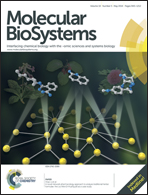Structural modeling and molecular dynamics studies on the human LMTK3 domain and the mechanism of ATP binding†
Abstract
Estrogen positive breast cancer is a dreadful disease in women worldwide. The human estrogen receptor-α (ERα) pathway plays a critical role in estrogenic signaling and targeting ERα in breast cancer treatment. The key role of Lemur tyrosine kinase-3 (LMTK3) in regulation of ERα has been identified and it is found to be a novel therapeutic target for breast cancer. With lack of structural studies on LMTK3, the breast cancer therapeutics research remains elusive. In this computational study, we performed structural studies on LMTK3 by structural modeling and molecular dynamics (MD) simulations of the apo state and the ATP bound state. The structure of the LMTK3 domain was developed by using I-TASSER server and validated by quality index and Ramachandran plot. MD simulation analysis explained the structural behavior of the LMTK3 domain in the dynamic system and the apo state showed defined protein folding with stable conformation. The mechanism of ATP binding was studied using molecular docking, resulting in the identification of critical residues and the ATP binding cavity. Furthermore, MD simulation of the LMTK3–ATP complex was performed and the trajectory analyses confirmed the stability and effective binding of ATP in the dynamic system. Overall, our computational reports provide more information on the structure–function relationship of LMTK3 with ATP. The critical residues Tyr185 and Asp284 found in the ATP binding cavity may be useful in designing potential inhibitors on human LMTK3.


 Please wait while we load your content...
Please wait while we load your content...